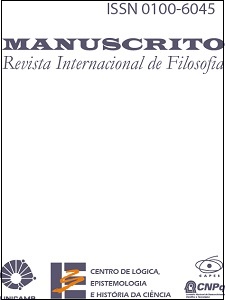Resumo
In his book Logical Forms Chateaubriand proposes, among other things, a theory of truth according to which a true statement describes some aspect of the world. The aim of this paper is to assess Chateaubriand’s claim that his theory of truth is compatible with the main intuition underlying the correspondence theory.Referências
AQUINAS, T. Summa Theologica. Chicago: Encyclopedia Britannica, Inc.,
CHATEAUBRIAND, O. Logical Forms. Part I. Truth and Description. Campinas: Centro de Lógica, Epistemologia e História da Ciência/ UNICAMP, 2001. (Coleção CLE, 34)
FREGE. G Collected Papers on Mathematics, Logic, and Philosophy. Edited by B. McGuiness, Oxford: Blackwell, 1984.
———. “The Thought: A Logical Inquiry”. In: B. McGuiness (ed.) (1984), pp. 351-372.
HEMPEL. C. G. “On the Logical Positivists’ Theory of Truth”. In: Horwich (ed.) (1994), pp. 79-90.
HORWICH, P. (ed.). Theories of Truth. Dartmouth: Dartmouth Publishing
Company, 1994.
RUSSELL. B. The Philosophy of Logical Atomism. Chicago and Illinois: Open Court, 1996.
SCHLICK. M. “Facts and Propositions”. In: Horwich (ed.) (1994), pp. 91-96.
WITTGENSTEIN. L. Tractatus Logico-Philosophicus. London: Routledge &
Kegan Paul, 1981.

